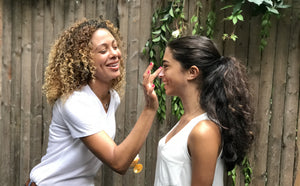We founded Love Sun Body over a simple conversation about sunscreen. That conversation drove the research and development that created our brand ethos and sunscreen formulas: What is ‘truly’ effective and what is ‘truly’ natural sunscreen: "safe for your body & the planet".
For seven years, we have researched mineral sunscreen filters and chemical sunscreen filters. The chemical filters are all made in a laboratory, then manufactured in large quantities, that are cheap. And they are hazardous.
The chemicals in sunscreen don't just sit on top of the skin, they absorb in the bloodstream.
According to studies by the Center for Drug Evaluation and Research, an arm of the US Food and Drug Administration after a single application, a total of seven chemicals commonly found in sunscreens can be absorbed into the bloodstream at levels that exceed safety thresholds.
The study published Tuesday, January 21, 2020 in the peer-reviewed Journal of the American Medical Association (JAMA) found that seven active ingredients in different sunscreens enter the bloodstream at levels that far exceed the FDA's recommended threshold without a government safety inspection.
This study evaluated absorption of the active ingredients avobenzone, oxybenzone, octocrylene, homosalate, octisalate, and octinoxate. The prior study evaluated absorption of avobenzone, oxybenzone, octocrylene, and ecamsule. Without further testing, the FDA does not know what levels of absorption can be considered safe.
"What is most alarming about these findings is that chemicals are absorbing into the body in significant amounts and the ingredients have not been fully tested for safety," said David Andrews, a senior scientist for the Environmental Working Group, or EWG, a consumer organization which advocates for sunscreen safety. "If companies want to keep these ingredients in products, they need to urgently test for potential harm to children and harm from long-term use," Andrews added.
All of these chemicals are part of a dozen that the FDA wants manufacturers to research before they can be considered GRASE or "generally regarded as safe and effective."
Participants in the new study were asked to apply sunscreen on 75% of their bodies the first day. On days two through four, they were asked to apply the same amount at four times during the day. After initial absorption, the concentration of the six chemicals in the blood increased each day of application, and remained above FDA safety levels at day seven, well after application had ended. Two of the chemicals -- homosalate and oxybenzone -- were still above safety thresholds at day 21.
"It seems likely that some of it is getting absorbed into the blood long after the sunscreen applications and in part that is why levels in blood stay high weeks after application," Andrews said.
One in five Americans will develop skin cancer by the age of 70, the Skin Cancer Foundation says. Around the world, melanoma ranks as the 19th most common cancer in both men and women, according to the World Cancer Research Fund.
In the United States, sunscreens were originally approved as an over-the-counter solution to sunburn. They came in two types: one using chemical combos to filter the sun, the other using minerals to block the sun such as titanium dioxide or zinc oxide.
Because of the way they were used at the time, there wasn't a lot of concern about a potential health impact. But that soon changed, and the FDA began to ask the industry for safety testing.
Critics say it has dragged its heels over the years, thus pushing the FDA to do the initial studies.
"The FDA is turning up the heat on sunscreen manufactures by doing their own testing and finding that the most common sunscreen chemicals absorb through the skin and into blood at levels that could cause harm," the EWG's Andrews said.
"It is outrageous that over a decade ago, nearly every American tested by CDC had oxybenzone in their blood, an ingredient linked to hormone disruption, and still manufacturers have resisted safety testing," he added.
Skin absorption levels of three of the chemical sun filters in the study -- homosalate, octisalate, and octinoxate -- in commercial sunscreens had not been previously studied, the FDA researchers wrote in the study.
However, they pointed to studies that have "raised questions about whether oxybenzone and homosalate" might affect hormone activity.
In the 2019 study, "oxybenzone was absorbed into the body at about 50 to 100 times higher concentration" than the others tested, Andrews said.
Research has shown a potential link between oxybenzone and lower testosterone levels in adolescent boys, hormone changes in men, and shorter pregnancies and disrupted birth weights in babies. However, researchers caution about assuming an association between exposure and those outcomes.
A 2008 Swiss study found oxybenzone or one of four other sunscreen chemicals in 85% of breast milk samples, sparking concern that newborns could be exposed. A 2010 study found another of the studied chemicals, octinoxate, in breast milk.
In 2008, the US Centers for Disease Control and Prevention analyzed urine samples collected by a government study and found oxybenzone in 97% of the samples.
Of all of the sunscreen ingredients, oxybenzone is known to be the most common cause of contact allergies; a 10-year study found that 70% of people had a positive patch test when exposed.
The European Union has mostly replaced oxybenzone in its sunscreen products with newer, more protective substances that block out more of the dangerous UVB and UVA rays. But those newer products have not passed the safety tests needed for FDA approval. So oxybenzone remains in use; in fact, a 2018 report by the EWG estimated that it was in two-thirds of all chemically based sunscreens sold in the United States.
In addition, Hawaii, the Pacific nation of Palau, U.S. Virgin Islands and Key West have banned chemical sunscreens containing oxybenzone and octinoxate because they cause coral bleaching and are dangerous to marine ecosystems.
Experts and the FDA stress the sun's link to cancer and aging is real, so don't abandon sun protection. Suggestions include long-sleeved clothing, hats, sunglasses and staying in the shade and mineral-based sunscreens containing titanium dioxide and zinc oxide, which the FDA has determined are generally considered safe and effective.

